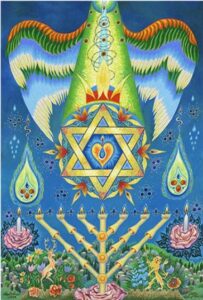בס”ד
By Rabbi Moshe Goodman, Kollel Ohr Shlomo, Hebron

In this painting we find the Menora as a central feature along with the Star of David. Both images carry the theme of six aspects centered towards a central seventh aspect, which is in the Menora the seventh central beam, and in the Star of David the central hollowed space here also accentuated with a heart, candle, and drop of water. The heart symbol here may express that the central holy seventh aspect is the “heart” of all matter, also able to bring unity between fire/the candle and water drops, considered opposites. In the past, we have discussed how the census of Israel comes out to the number of six hundred thousand approximately. Indeed, the Kabbalists tie this number six with the six days of Creation. With that there is also a seventh aspect, just like Shabbat, the holy day, is the seventh day. This seventh aspect correlates with the Levites, enumerated separately, who deal with the holy internal service. These ideas can be depicted in the Star of David which has six points/hollow spaces within them, but yet also has an internal hollow space in the middle, corresponding to the seventh aspect. This matter may explain why the central beam of the Menora is discussed in our parsha in conjunction with the offerings of the twelve princes of each tribe that camped around the Mishkan where the Menora was lit. The identification of the Menora with the central force amongst the tribes may also explain the lion and deer figures seen to the sides of the Menora, since the first tribe of Yehuda, mentioned among the princes, is likened to a lion, while the last tribe mentioned, Naftali, is likened to a deer.
Our Sages also consider the Menora a symbol of the Holy Presence. This matter may also explain why we see roses with candles within them to the sides of the Menora and the Menora itself emerging from a rose, since the rose is associated by the Kabbalists also to the Holy Presence/”Assembly of Israel”, and the candle represents its spiritual illumination or “soul light.”
To the right and left we see ten drops of water, the highest drop being aloof from the others, and the tenth being much larger and “containing pomegranates.” This seems to allude to the ten sefirot, as the highest sefira “keter” is considered to be “aloof” from the other sefirot, and the tenth lowest sefira – “malchut” – is considered to be the most “pronounced” towards us and is also associated by the Kabbalists with the concept “mitzva” which is also associated with the many seeds of the pomegranate. Just next to the drops, we see four groups of three dots, which quite clearly allude to the twelve tribes, we just discussed, which have this configuration in their encampments around the Mishkan in the Wilderness.
Indeed, Hebron as well, carrying the Maarat Hamachpela as a focal point of the Holy Presence, is a central unifying force of our People. “Hibur – Hebron!”



